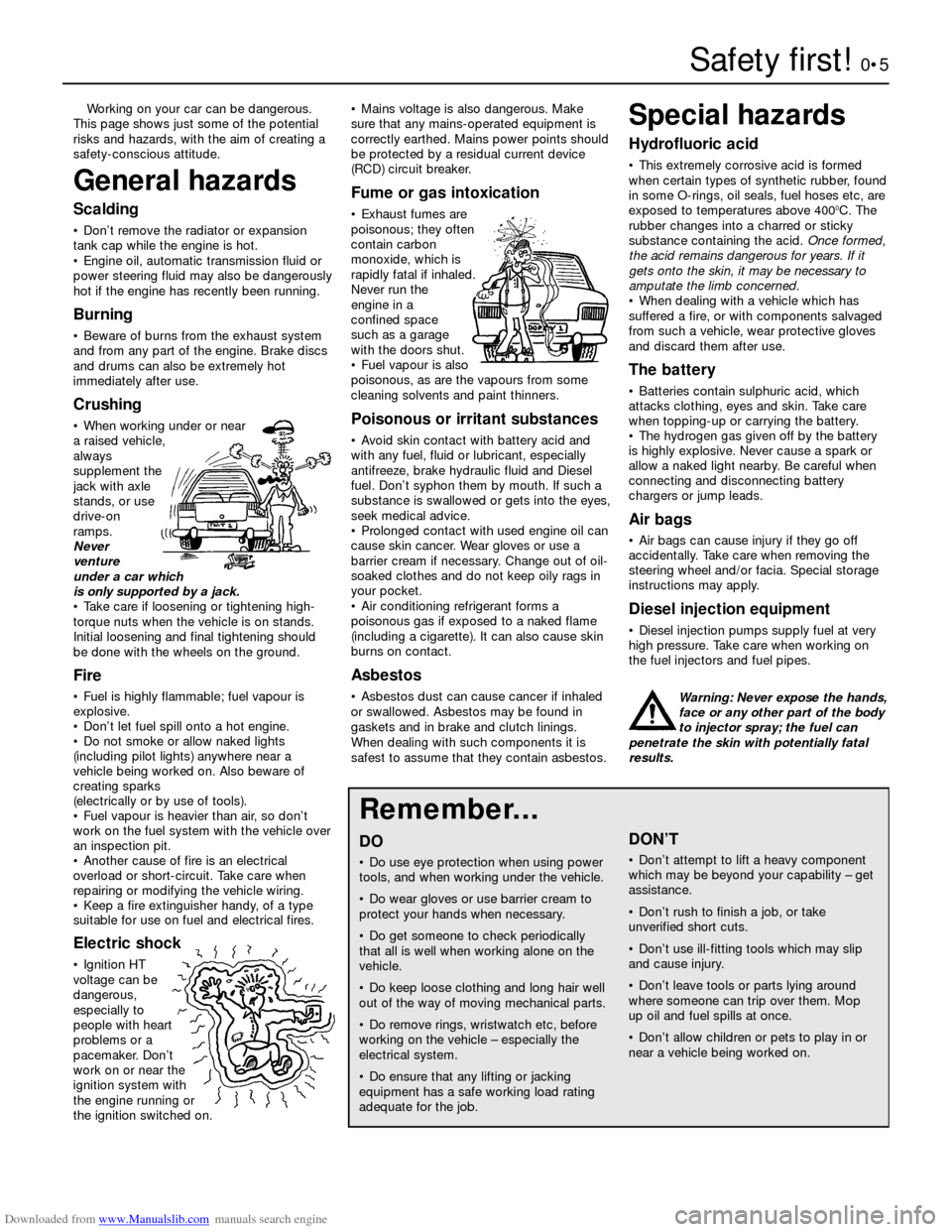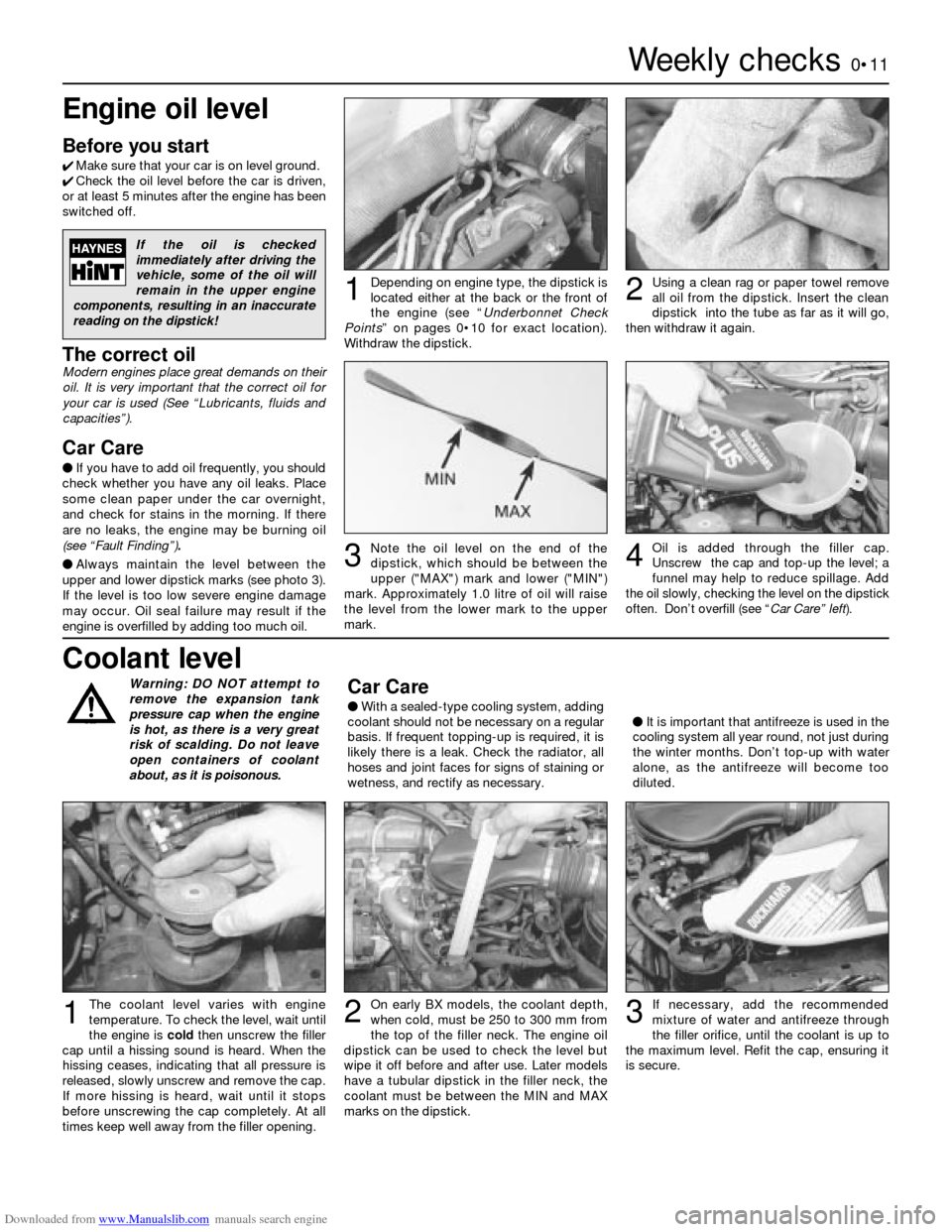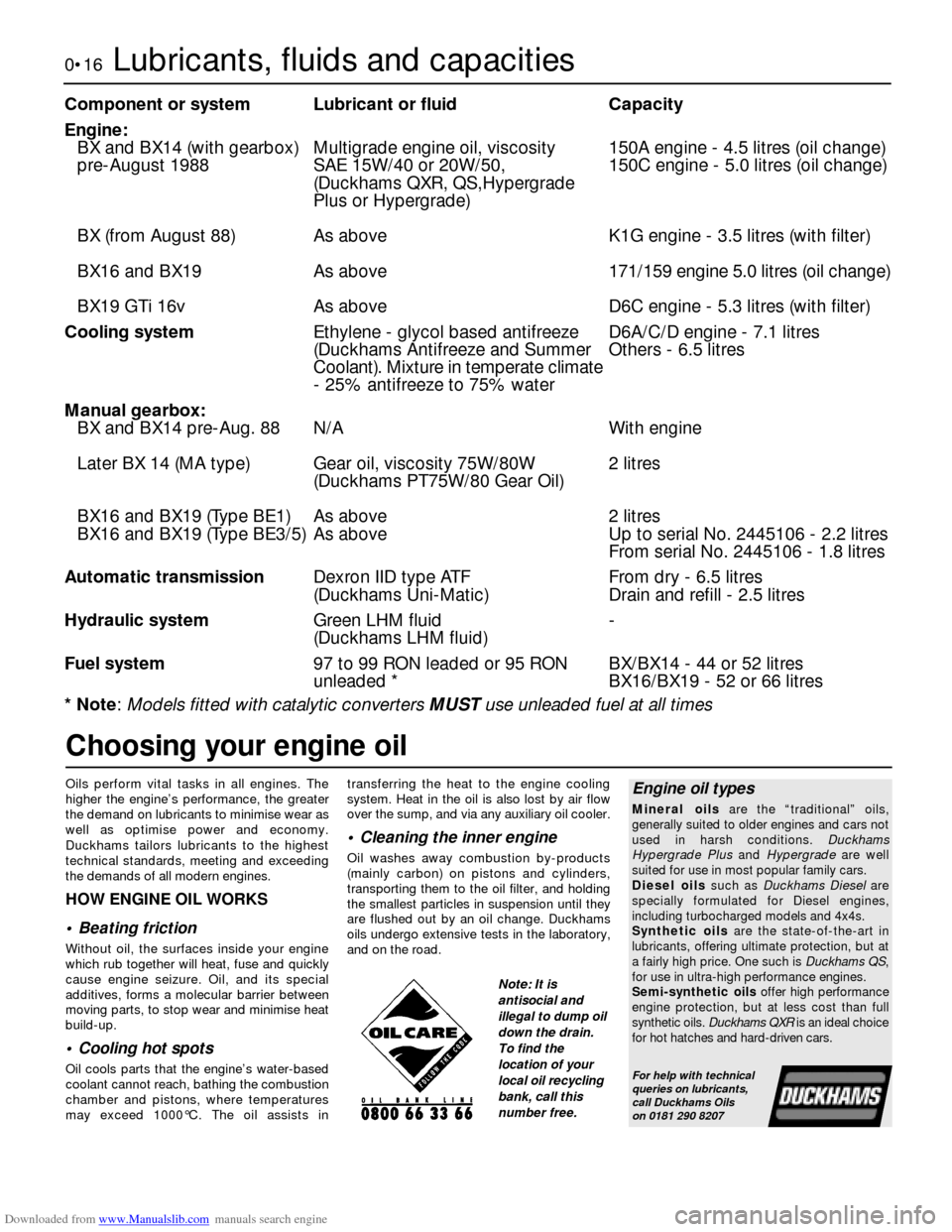oil type Citroen BX HATCHBACK 1991 2.G Workshop Manual
[x] Cancel search | Manufacturer: CITROEN, Model Year: 1991, Model line: BX HATCHBACK, Model: Citroen BX HATCHBACK 1991 2.GPages: 16, PDF Size: 0.47 MB
Page 4 of 16

Downloaded from www.Manualslib.com manuals search engine The Citroën BX was introduced in France in October of 1982 and
became available in the UK in September 1983. The original models
available in the range were the BX, BX 14 E, BX 14 RE, BX 16 RS and BX
16 TRS. The types of engine, transmission and equipment fitted being
dependent on the model and the body design being that of a Hatchback.
For the 1985 model year, the BX 19 GT was made available for the
driver requiring a higher performance model. Also in 1985, the BX
Leader replaced the BX and BX 14 models, the Leader being fitted with
the same engine and transmission as the BX 14. In the second half of
1985 the Estate was introduced, two versions being available, the BX
16 RS Estate and the BX 16 TRS Estate.
Changes for the 1987 model year included the introduction of the BX
16 RE Hatchback, the BX 19 GTi (fuel injection and ABS braking), the
BX 19 GTi 16v (16 valve engine) and the replacement for the BX 19 GT,
the BX 19 TRS. Also, a BX 19 TRS Estate fitted with automatic
transmission became available. The facia and instruments were
modified on all models, with round instruments being used. Other
aesthetic improvements were made to improve the external
appearance of certain models.For the 1988 model year, all BX 14 models were equipped with the
K1G engine with 2CA type 4 or 5-speed manual gearbox.
For the 1989 model year, BX 16 and BX 19 models were equipped
with the BE3 5-speed manual gearbox to replace the earlier BE1 5-
speed type.
In early 1990, BX 19 TZi Hatchback and Estate models became
available, these being equipped with catalytic converters.
In late 1992, BX 16 TXi catalytic converter equipped Hatchback and
Estate models were added to the range.
On all models, the engine and transmission is mounted transversely
and drives the front wheels through two driveshafts. The transmission
available (depending on model type) is a 4 or 5-speed manual gearbox
or a 4-speed automatic unit.
All models are extremely comfortable to ride in, thanks to the
hydropneumatic suspension and luxurious interior trim. The unique
design suspension is self-levelling and the ride height is maintained
automatically over all road conditions. A ground clearance lever inside
the car may be used to adjust the ride height when travelling over
rough ground, this also makes changing a roadwheel much simpler.
Your Citroën BX Manual
The aim of this Manual is to help you get the best value from your
vehicle. It can do so in several ways. It can help you decide what work
must be done (even should you choose to get it done by a garage),
provide information on routine maintenance and servicing, and give a
logical course of action and diagnosis when random faults occur.
However, it is hoped that you will use the Manual by tackling the work
yourself. On simpler jobs it may even be quicker than booking the car
into a garage and going there twice, to leave and collect it. Perhaps
most important, a lot of money can be saved by avoiding the costs a
garage must charge to cover its labour and overheads.
The Manual has drawings and descriptions to show the function of
the various components so that their layout can be understood. Then
the tasks are described and photographed in a clear step-by-step
sequence.
Acknowledgements
Thanks are due to Champion Spark Plug who supplied the illustrations
showing spark plug conditions, and to Duckhams Oils, who provided
lubrication data. Certain other illustrations are the copyright of Citroën
(UK) Limited and are used with their permission. Thanks are also due to
Sykes-Pickavant Limited, who supplied some of the workshop tools,
and to all those people at Sparkford who helped in the production of
this Manual.
We take great pride in the accuracy of information given in this
manual, but vehicle manufacturers make alterations and design
changes during the production run of a particular vehicle of which
they do not inform us. No liability can be accepted by the authors
or publishers for loss, damage or injury caused by any errors in, or
omissions from the information given.
0•4Introduction
The Citroën BX Team
Haynes manuals are produced by dedicated and
enthusiastic people working in close co-operation. The
team responsible for the creation of this book included:
Authors Ian Coomber
Christopher Rogers
Sub-editors Sophie Yar
Carole Turk
Editor & Page Make-up Steve Churchill
Bob Jex
Workshop manager Paul Buckland
Photo Scans John Martin
Paul Tanswell
Steve Tanswell
Cover illustration & Line Art Roger Healing
We hope the book will help you to get the maximum
enjoyment from your car. By carrying out routine
maintenance as described you will ensure your car’s
reliability and preserve its resale value.
Citroën BX 19 GTiCitroën BX 16 TRS
Page 5 of 16

Downloaded from www.Manualslib.com manuals search engine Safety first!0•5
Working on your car can be dangerous.
This page shows just some of the potential
risks and hazards, with the aim of creating a
safety-conscious attitude.
General hazards
Scalding
• Don’t remove the radiator or expansion
tank cap while the engine is hot.
• Engine oil, automatic transmission fluid or
power steering fluid may also be dangerously
hot if the engine has recently been running.
Burning
• Beware of burns from the exhaust system
and from any part of the engine. Brake discs
and drums can also be extremely hot
immediately after use.
Crushing
• When working under or near
a raised vehicle,
always
supplement the
jack with axle
stands, or use
drive-on
ramps.
Never
venture
under a car which
is only supported by a jack.
• Take care if loosening or tightening high-
torque nuts when the vehicle is on stands.
Initial loosening and final tightening should
be done with the wheels on the ground.
Fire
• Fuel is highly flammable; fuel vapour is
explosive.
• Don’t let fuel spill onto a hot engine.
• Do not smoke or allow naked lights
(including pilot lights) anywhere near a
vehicle being worked on. Also beware of
creating sparks
(electrically or by use of tools).
• Fuel vapour is heavier than air, so don’t
work on the fuel system with the vehicle over
an inspection pit.
• Another cause of fire is an electrical
overload or short-circuit. Take care when
repairing or modifying the vehicle wiring.
• Keep a fire extinguisher handy, of a type
suitable for use on fuel and electrical fires.
Electric shock
• Ignition HT
voltage can be
dangerous,
especially to
people with heart
problems or a
pacemaker. Don’t
work on or near the
ignition system with
the engine running or
the ignition switched on.• Mains voltage is also dangerous. Make
sure that any mains-operated equipment is
correctly earthed. Mains power points should
be protected by a residual current device
(RCD) circuit breaker.
Fume or gas intoxication
• Exhaust fumes are
poisonous; they often
contain carbon
monoxide, which is
rapidly fatal if inhaled.
Never run the
engine in a
confined space
such as a garage
with the doors shut.
• Fuel vapour is also
poisonous, as are the vapours from some
cleaning solvents and paint thinners.
Poisonous or irritant substances
• Avoid skin contact with battery acid and
with any fuel, fluid or lubricant, especially
antifreeze, brake hydraulic fluid and Diesel
fuel. Don’t syphon them by mouth. If such a
substance is swallowed or gets into the eyes,
seek medical advice.
• Prolonged contact with used engine oil can
cause skin cancer. Wear gloves or use a
barrier cream if necessary. Change out of oil-
soaked clothes and do not keep oily rags in
your pocket.
• Air conditioning refrigerant forms a
poisonous gas if exposed to a naked flame
(including a cigarette). It can also cause skin
burns on contact.
Asbestos
• Asbestos dust can cause cancer if inhaled
or swallowed. Asbestos may be found in
gaskets and in brake and clutch linings.
When dealing with such components it is
safest to assume that they contain asbestos.
Special hazards
Hydrofluoric acid
• This extremely corrosive acid is formed
when certain types of synthetic rubber, found
in some O-rings, oil seals, fuel hoses etc, are
exposed to temperatures above 400
0C. The
rubber changes into a charred or sticky
substance containing the acid. Once formed,
the acid remains dangerous for years. If it
gets onto the skin, it may be necessary to
amputate the limb concerned.
• When dealing with a vehicle which has
suffered a fire, or with components salvaged
from such a vehicle, wear protective gloves
and discard them after use.
The battery
• Batteries contain sulphuric acid, which
attacks clothing, eyes and skin. Take care
when topping-up or carrying the battery.
• The hydrogen gas given off by the battery
is highly explosive. Never cause a spark or
allow a naked light nearby. Be careful when
connecting and disconnecting battery
chargers or jump leads.
Air bags
• Air bags can cause injury if they go off
accidentally. Take care when removing the
steering wheel and/or facia. Special storage
instructions may apply.
Diesel injection equipment
• Diesel injection pumps supply fuel at very
high pressure. Take care when working on
the fuel injectors and fuel pipes.
Warning: Never expose the hands,
face or any other part of the body
to injector spray; the fuel can
penetrate the skin with potentially fatal
results.
Remember...
DO
• Do use eye protection when using power
tools, and when working under the vehicle.
• Do wear gloves or use barrier cream to
protect your hands when necessary.
• Do get someone to check periodically
that all is well when working alone on the
vehicle.
• Do keep loose clothing and long hair well
out of the way of moving mechanical parts.
• Do remove rings, wristwatch etc, before
working on the vehicle – especially the
electrical system.
• Do ensure that any lifting or jacking
equipment has a safe working load rating
adequate for the job.
A few tips
DON’T
• Don’t attempt to lift a heavy component
which may be beyond your capability – get
assistance.
• Don’t rush to finish a job, or take
unverified short cuts.
• Don’t use ill-fitting tools which may slip
and cause injury.
• Don’t leave tools or parts lying around
where someone can trip over them. Mop
up oil and fuel spills at once.
• Don’t allow children or pets to play in or
near a vehicle being worked on.
Page 11 of 16

Downloaded from www.Manualslib.com manuals search engine Weekly checks0•11
Engine oil level
Before you start
4Make sure that your car is on level ground.
4Check the oil level before the car is driven,
or at least 5 minutes after the engine has been
switched off.
The correct oilModern engines place great demands on their
oil. It is very important that the correct oil for
your car is used (See “Lubricants, fluids and
capacities”).
Car Care
l If you have to add oil frequently, you should
check whether you have any oil leaks. Place
some clean paper under the car overnight,
and check for stains in the morning. If there
are no leaks, the engine may be burning oil
(see “Fault Finding”).
lAlways maintain the level between the
upper and lower dipstick marks (see photo 3).
If the level is too low severe engine damage
may occur. Oil seal failure may result if the
engine is overfilled by adding too much oil.
If the oil is checked
immediately after driving the
vehicle, some of the oil will
remain in the upper engine
components, resulting in an inaccurate
reading on the dipstick!
Depending on engine type, the dipstick is
located either at the back or the front of
the engine (see “Underbonnet Check
Points” on pages 0•10 for exact location).
Withdraw the dipstick.Using a clean rag or paper towel remove
all oil from the dipstick. Insert the clean
dipstick into the tube as far as it will go,
then withdraw it again.
Note the oil level on the end of the
dipstick, which should be between the
upper ("MAX") mark and lower ("MIN")
mark. Approximately 1.0 litre of oil will raise
the level from the lower mark to the upper
mark.Oil is added through the filler cap.
Unscrew the cap and top-up the level; a
funnel may help to reduce spillage. Add
the oil slowly, checking the level on the dipstick
often. Don’t overfill (see “Car Care” left).
12
34
Warning: DO NOT attempt to
remove the expansion tank
pressure cap when the engine
is hot, as there is a very great
risk of scalding. Do not leave
open containers of coolant
about, as it is poisonous.Car Care
lWith a sealed-type cooling system, adding
coolant should not be necessary on a regular
basis. If frequent topping-up is required, it is
likely there is a leak. Check the radiator, all
hoses and joint faces for signs of staining or
wetness, and rectify as necessary.lIt is important that antifreeze is used in the
cooling system all year round, not just during
the winter months. Don’t top-up with water
alone, as the antifreeze will become too
diluted.
Coolant level
The coolant level varies with engine
temperature. To check the level, wait until
the engine is cold then unscrew the filler
cap until a hissing sound is heard. When the
hissing ceases, indicating that all pressure is
released, slowly unscrew and remove the cap.
If more hissing is heard, wait until it stops
before unscrewing the cap completely. At all
times keep well away from the filler opening.On early BX models, the coolant depth,
when cold, must be 250 to 300 mm from
the top of the filler neck. The engine oil
dipstick can be used to check the level but
wipe it off before and after use. Later models
have a tubular dipstick in the filler neck, the
coolant must be between the MIN and MAX
marks on the dipstick.If necessary, add the recommended
mixture of water and antifreeze through
the filler orifice, until the coolant is up to
the maximum level. Refit the cap, ensuring it
is secure.123
Page 16 of 16

Downloaded from www.Manualslib.com manuals search engine 0•16Lubricants, fluids and capacities
Component or system Lubricant or fluid Capacity
Engine:
BX and BX14 (with gearbox) Multigrade engine oil, viscosity 150A engine - 4.5 litres (oil change)
pre-August 1988 SAE 15W/40 or 20W/50, 150C engine - 5.0 litres (oil change)
(Duckhams QXR, QS,Hypergrade
Plus or Hypergrade)
BX (from August 88) As above K1G engine - 3.5 litres (with filter)
BX16 and BX19 As above171/159 engine 5.0 litres (oil change)
BX19 GTi 16v As above D6C engine - 5.3 litres (with filter)
Cooling systemEthylene - glycol based antifreeze D6A/C/D engine - 7.1 litres
(Duckhams Antifreeze and Summer Others - 6.5 litres
Coolant). Mixture in temperate climate
- 25% antifreeze to 75% water
Manual gearbox:
BX and BX14 pre-Aug. 88 N/A With engine
Later BX 14 (MA type) Gear oil, viscosity 75W/80W 2 litres
(Duckhams PT75W/80 Gear Oil)
BX16 and BX19 (Type BE1) As above 2 litres
BX16 and BX19 (Type BE3/5) As above Up to serial No. 2445106 - 2.2 litres
From serial No. 2445106 - 1.8 litres
Automatic transmissionDexron IID type ATF From dry - 6.5 litres
(Duckhams Uni-Matic) Drain and refill - 2.5 litres
Hydraulic systemGreen LHM fluid -
(Duckhams LHM fluid)
Fuel system97 to 99 RON leaded or 95 RON BX/BX14 - 44 or 52 litres
unleaded * BX16/BX19 - 52 or 66 litres
* Note: Models fitted with catalytic converters MUSTuse unleaded fuel at all times
Oils perform vital tasks in all engines. The
higher the engine’s performance, the greater
the demand on lubricants to minimise wear as
well as optimise power and economy.
Duckhams tailors lubricants to the highest
technical standards, meeting and exceeding
the demands of all modern engines.
HOW ENGINE OIL WORKS
• Beating friction
Without oil, the surfaces inside your engine
which rub together will heat, fuse and quickly
cause engine seizure. Oil, and its special
additives, forms a molecular barrier between
moving parts, to stop wear and minimise heat
build-up.
• Cooling hot spots
Oil cools parts that the engine’s water-based
coolant cannot reach, bathing the combustion
chamber and pistons, where temperatures
may exceed 1000°C. The oil assists intransferring the heat to the engine cooling
system. Heat in the oil is also lost by air flow
over the sump, and via any auxiliary oil cooler.
• Cleaning the inner engine
Oil washes away combustion by-products
(mainly carbon) on pistons and cylinders,
transporting them to the oil filter, and holding
the smallest particles in suspension until they
are flushed out by an oil change. Duckhams
oils undergo extensive tests in the laboratory,
and on the road.
Engine oil types
Mineral oilsare the “traditional” oils,
generally suited to older engines and cars not
used in harsh conditions. Duckhams
Hypergrade Plus and Hypergradeare well
suited for use in most popular family cars.
Diesel oilssuch as Duckhams Dieselare
specially formulated for Diesel engines,
including turbocharged models and 4x4s.
Synthetic oilsare the state-of-the-art in
lubricants, offering ultimate protection, but at
a fairly high price. One such is Duckhams QS,
for use in ultra-high performance engines.
Semi-synthetic oilsoffer high performance
engine protection, but at less cost than full
synthetic oils. Duckhams QXRis an ideal choice
for hot hatches and hard-driven cars.
For help with technical
queries on lubricants,
call Duckhams Oils
on 0181 290 8207
Choosing your engine oil
Note: It is
antisocial and
illegal to dump oil
down the drain.
To find the
location of your
local oil recycling
bank, call this
number free.